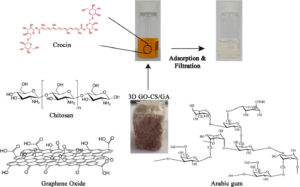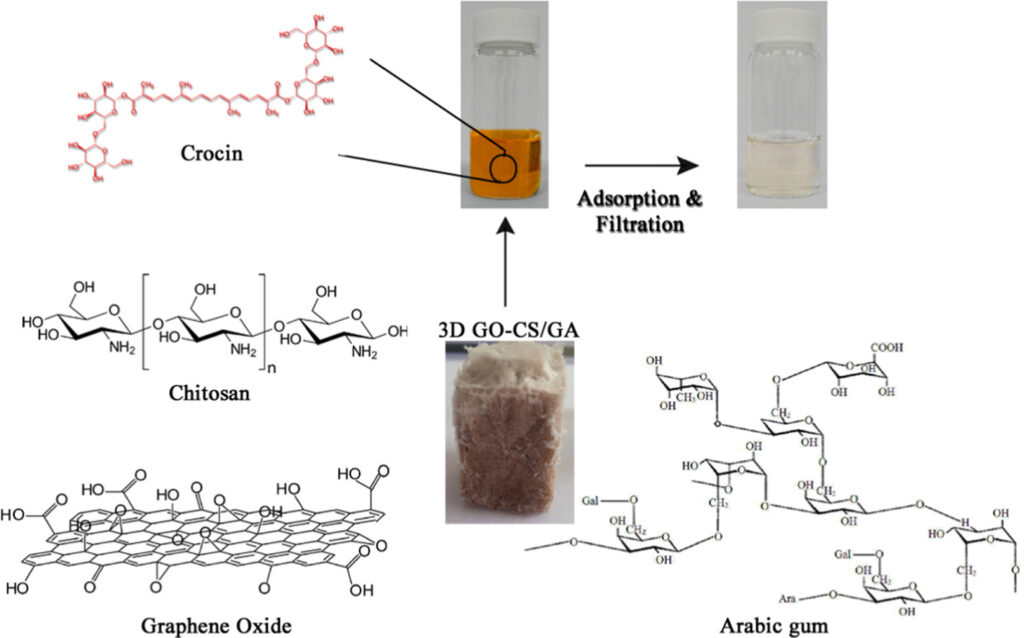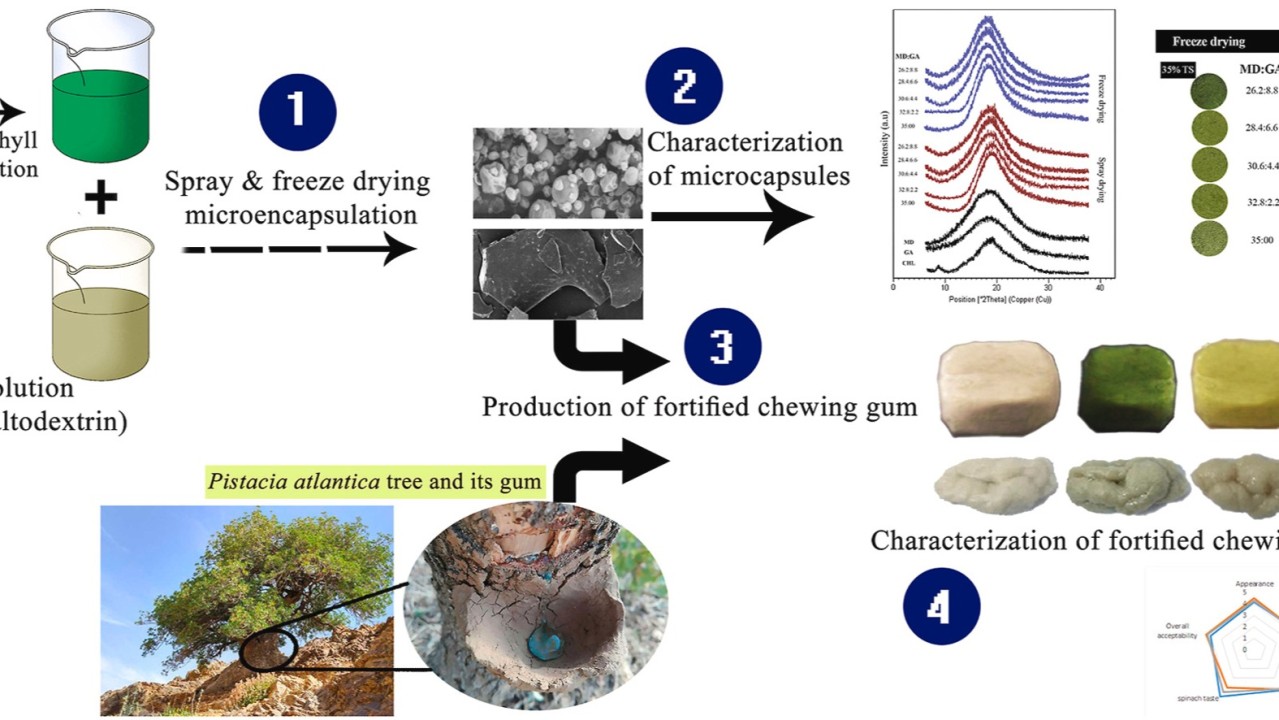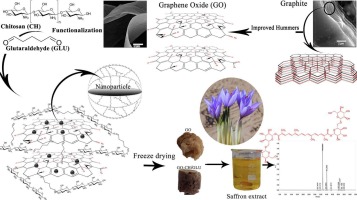Highlights
-
Graphene oxide nanocomposites with chitosan-Arabic gum were synthesized.
-
They were employed for the adsorption/purification of crocin from saffron.
-
The nanocomposites separated 99.1% of crocin in an equilibrium time of 30 min.
- a
- Faculty of Food Science and Technology, Gorgan University of Agricultural Sciences and Natural Resources, Gorgan, Iran
- b
- Department of Food Quality Control and Safety, Research Institute of Food Science and Technology, Mashhad, Iran
- c
- Faculty of pharmaceuticals, Mashhad University of Medical Sciences, Mashhad, Iran
Received 5 April 2021, Revised 10 May 2021, Accepted 4 July 2021, Available online 7 July 2021, Version of Record 7 July 2021.
Abstract
This work provides a new perception toward the application of the graphenic-biopolymeric composites as a solid-bed for separation and purification of bioactive compounds. Graphene oxide nanocomposites with functionalized sheets by soluble and insoluble nanocomplexes of chitosan and Arabic gum, were successfully synthesized and employed for the adsorption and purification of crocin, a nutraceutical from saffron. The composites exhibited a nanostructured scaffold with a particle size of 10 nm and experienced an unprecedented increase in the surface area by about 300% and improved d-spacing sheets by 17%. The optimum conditions for crocin separation were temperature = 318 K, stirring rate = 300 rpm, initial concentration = 100 mg L−1 and pH = 6. Under these conditions, the nanocomposites separated 99.1% of crocin in an equilibrium time of 30 min. The adsorption data were best represented by Freundlich isotherm and pseudo-second-order kinetic models. The thermodynamic studies indicated that the crocin adsorption on nanocomposites was an endothermic, spontaneous and physisorption process. The high-performance liquid chromatography (HPLC) analysis revealed that produced nanocomposites adsorbed crocin efficiently from saffron extract with a purity similar to the standard sample. The possible interaction mechanisms between crocin and nanocomposites were electrostatic interactions and hydrogen bonding.
Graphical abstract

Introduction
During the last decade, nano‑carbons owing to their potential toward meeting human needs have been stood in the center of research in different fields. Graphene (G) as a layered honeycomb crystal structure of 2D layers of sp2-bonded carbon, has sparked much interest in the consequence of its unique properties including ultrahigh specific surface area, flat structure, high Young’s modulus, and fracture strength [1], [2], [3]. The controlled oxidation of G sheets leads to producing a heavily oxygenated derivative, that its basal plane is decorated by functional groups of hydroxyl and epoxide while bearing carbonyl and carboxyl groups on the edge of the sheet, named graphene oxide (GO) [4], [5]. The surface modification of GO could improve its physicochemical properties [6], which can be achieved through the interaction of different molecules of interest with these oxygenated functional groups (OFGs) [7]. For instance, Rajabi et al. [6] synthesized a 3D nanocomposite of GO with decorated sheets by nanoparticles of complexed Arabic gum (AG)/chitosan (CS). On the other hand, the ability of GO to form colloidal suspensions [8] makes it possible to shape different dimensional structures as an excellent adsorbent for a great amount of different molecules [9], [10].
Saffron as the world’s most expensive spice has gained popularity not only due to its unique color, taste, and aroma, but also because of its majestic pharmaceutical properties such as memory enhancing [11], antidepressant and anxiolytic [12], aphrodisiac [13], and neuroprotective [14] properties. The main bioactive compound of saffron, responsible for its color and pharmaceutical features, is crocin(s), an exceptional water soluble carotenoid. Crocin refers to a group of crocetin esters that are categorized based on their sugar moieties and crocin-1 is the main member of this group [15], as depicted in Fig. 1.
Different kinds of drugs with different therapeutic goals have been produced from crocin such as Crocina (Iran), Exir (USA), Caruso’s (Australia), Saffronia (Australia), and Depromin (Finland). Accordingly, many attempts have been made to purify crocin [16], [17], but none of them can be commercialized and the need for a comprehensive approach remains tangible. On the other hand, the use of GO until now has been practiced as a filter to remove unpleasant compounds and pollutants such as heavy metals, synthetic colors, and residual drugs.
So, our approach was to introduce a scalable-feasible crocin purification method from the saffron extract using a 3D nanocomposite of GO-CS/AG. The biopolymers of CS and AG were combined with GO dispersion, to improve its physicochemical properties toward crocin adsorption from the saffron extract. Moreover, given the need to eliminate the prolonged ultrahigh centrifugation process for precipitating the dispersed GO, its 3D structure was prepared. The physicochemical properties of nanostructures were analyzed using field emission scanning electron microscope (FE-SEM), X-ray diffraction (XRD), transmission electron microscopy (TEM), Fourier-transform infrared spectroscopy (FTIR), Brunauer-Emmett-Teller (BET) and Barrett–Joyner–Halenda (BJH) methods. The purity of crocin was also evaluated through high-performance liquid chromatography (HPLC).
Section snippets
Materials and methods
Fresh saffron was picked from a farm around Kashmar (Khorasan-Razavi province, Iran) followed by stigma separation. Sample preparation was done as follows [18]: (i) stigma drying through microwave (1000 W, 3.5 min), (ii) crashing and sieving (0.421 mm mesh), and (iii) keeping saffron powder (SP) in air-tight plastic bags within a desiccator. The following chemicals were obtained from Sigma-Aldrich (USA): Natural graphite powder (>99.9% purity), low molecular weight chitosan (~120 kDa,
Characterization of biopolymeric nanoparticles
The results of analyzing the NPs showed that the mean diameter, polydispersity index (PDI), and zeta potential of complexed biopolymeric NPs were 148 nm, 0.22, and 39.80 mV, respectively. Fig. 2 represents the TEM and FE-SEM images of CS/AG NPs. The spherical shapes along with a smooth surface are the characteristics of prevailing NPs, revealing the successful bonding of BFGs to create uniform nano-sized complexes [6].
Characterization of nanocomposites
Fig. 3A represented the FTIR spectra for graphite (G), GO and nanocomposites.
Conclusion
The ability of ternary nanocomposites was explored toward adsorption of crocin from the saffron extract. The ternary nanocomposites were prepared through the combination of CS/AG solution containing both free and bonded complexes of two biopolymers with GO dispersion followed by freeze-drying. The nanocomposites were successfully synthesized and showed unprecedented structural properties than GO as confirmed by TEM, FE-SEM, XRD, FTIR, and BET analysis. These nanocomposites adsorbed >90% of
CRediT authorship contribution statement
Hamid Rajabi did the experiments and wrote the 1st draft of manuscript.
Seid Mahdi Jafari designed the framework of this study, finalized the manuscript and take responsibility of submissions and publishing stages.
Javad Feizy was the advisor for chemical instrumental analysis.
Mohammad Ghorbani contributed to discussion of instrumental data.
Seyed Ahmad Mohajeri was the advisor for the synthesis of GO and complexed biopolymers.
Declaration of competing interest
Authors declare no conflicts of interest regarding this paper.
Acknowledgements
This study was financially supported by the Iran National Science Foundation (INSF), Grant No. 96011404.
References (31)
- Q. Liu
Evaluation of graphene as an advantageous adsorbent for solid-phase extraction with chlorophenols as model analytes
J. Chromatogr. A
(2011) - H. He
A new structural model for graphite oxide
Chem. Phys. Lett.
(1998) - H. Rajabi
Preparation and characterization of 3D graphene oxide nanostructures embedded with nanocomplexes of chitosan-gum arabic biopolymers
Int. J. Biol. Macromol.
(2020) - B. Ghadrdoost
Protective effects of saffron extract and its active constituent crocin against oxidative stress and spatial learning and memory deficits induced by chronic stress in rats
Eur. J. Pharmacol.
(2011) - S.-M. Jafari
Bioactive ingredients of saffron: extraction, analysis, applications
- H. Rajabi
Retention of saffron bioactive components by spray drying encapsulation using maltodextrin, gum arabic and gelatin as wall materials
Food Hydrocoll.
(2015) - H. Rajabi
Chitosan-gum Arabic complex nanocarriers for encapsulation of saffron bioactive components
Colloids Surf. A Physicochem. Eng. Asp.
(2019) - M. Sarfarazi
Development of an environmentally-friendly solvent-free extraction of saffron bioactives using subcritical water
LWT
(2019) - D. Han
Preparation of chitosan/graphene oxide composite film with enhanced mechanical strength in the wet state
Carbohydr. Polym.
(2011) - S.M. Jafari
Bioavailability and release of bioactive components from nanocapsules
- H. Yan
pH-tunable surface charge of chitosan/graphene oxide composite adsorbent for efficient removal of multiple pollutants from water
Chem. Eng. J.
(2016) - B.Y.Z. Hiew
Review on synthesis of 3D graphene-based configurations and their adsorption performance for hazardous water pollutants
Process Saf. Environ. Prot.
(2018) - M. Ghobadi
MnFe2O4-graphene oxide magnetic nanoparticles as a high-performance adsorbent for rare earth elements: synthesis, isotherms, kinetics, thermodynamics and desorption
J. Hazard. Mater.
(2018) - S. Stankovich
Graphene-based composite materials
Nature
(2006) - V. Chabot
A review of graphene and graphene oxide sponge: material synthesis and applications to energy and the environment
Energy Environ. Sci.
(2014)
There are more references available in the full text version of this article.
Cited by (9)
-
Synthesis and characterization of three-dimensional graphene oxide-chitosan/ glutaraldehyde nanocomposites: Towards adsorption of crocin from saffron
2024, International Journal of Biological Macromolecules -
Characterization of microencapsulated spinach extract obtained by spray-drying and freeze-drying techniques and its use as a source of chlorophyll in a chewing gum based on Pistacia atlantica
2024, Food HydrocolloidsCitation Excerpt :CHL displayed two broad and indistinct peaks at 2θ = 8.6° and 19.5°, suggesting an amorphous structure with minimal crystallinity, a finding that aligns with previous research (Kang, Lee, Kim, & Chang, 2019). Both MD and GA also exhibited an amorphous structure, as indicated by the presence of broad peaks (Karrar et al., 2021; Rajabi, Jafari, Feizi, Ghorbani, & Mohajeri, 2021). Supporting our study’s objectives, the disappearance of CHL’s characteristic peaks in the XRD profiles of SD and FD particles, coupled with the amorphous structure of mCHL, confirms that CHL was primarily embedded within the GA-MD matrix.
-
APPLICATIONS OF SYNTHETIC AND HERBAL NANOPARTICLES AS APHRODISIACS: A SYSTEMATIC REVIEW
2024, International Journal of Applied Pharmaceutics -
Adsorbents for the purification and recovery of biocompounds: An updated review
2024, Biofuels, Bioproducts and Biorefining




